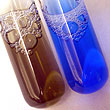|
Return to top |
 |
Melting Points of Lipids |
The melting points of lipids also tell us about their chemical structure. We'll examine the properties of some common fats and oils found in the kitchen: (A) lard, (B) olive oil, (C) safflower oil, and (D) butter.
|
|
These four tubes have just been removed from the freezer (a bit colder than 0' C or 32' F, the freezing point of water.) Notice that the lard (A), and butter (D) are solid, while both oils (B,C) remain liquid despite the freezing temperature. As the tubes warm up to room temperature (about 21' C, or 72' F), they remain much the same. The lard and butter stay solid, and the oils stay liquid.
This tells us that the melting points of the oils are lower than 0' C (because even freezing didn't make them solid), and the melting points for the lard and butter are higher than room temperature. But how much higher are they? |
After being heated for a few minutes at 37' C (human body temperature, or 98' F) the butter (D) has melted. See below for a close-up view of the tube. The lard (A) remains solid, and the oils remain liquid. This demonstrates that the melting point of butter is higher than room temperature but lower than the temperature of the human body. Lard, however, won't even melt when you eat it. |
|
 |
|
Saturation, Molecule Size, and Melting Points
The melting point demonstration shows us that the lipids from animals (lard, butter) are more saturated than the lipids from plants (olive oil, safflower oil). Also, while the oils appear to have similar melting points, the lard has a much higher melting point than the butter.
If the two animal fats have similar amounts of saturation, then why are their melting points so different? Saturation is only one of the things that can effect melting point. The size of the molecule also plays a role, and it is likely that the fat which makes up lard is a larger and more complex molecule than the fat found in butter. |
|
|
|
